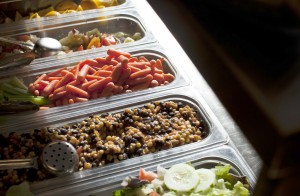The year in review: School nutrition and a look at those who do it well
This year has been an exciting one for school nutrition. In January, the United States Department of Agriculture (USDA) finalized the first updates to school meal standards in 17 years. This fall, the changes meant healthier meals were appearing in school cafeterias around the country. The guidelines help to bring the meals into line with the latest nutrition science by increasing the amount of fruits, vegetables, and whole grains, and decreasing saturated fat, sodium and excess calories. This is good news.
But while many schools around the country are successfully serving the healthier meals, some have gotten a lot of attention because of unhappy kids or overwhelmed staff. Thus, we thought it was time to shine a little light on those schools that are not only meeting the standards, but were out ahead of the curve and strengthened school nutrition before this year. Their stories – and the lessons they’ve learned – show that not only is it possible to serve healthier meals, it also can be appetizing to students and even profitable for schools.
One of the biggest improvements to school meals is an increase in the number and variety of fruits and vegetables. Carrolton City Schools in Georgia have been working on this for a couple of years and they encountered two major challenges – production time and storage space. To overcome these obstacles, the school district reconfigured its menus to pair more labor-intensive items like sliced fruit with more simply prepared foods such as a frozen vegetable. Schools also went from getting their produce deliveries once a week to twice a week to reduce the amount of storage space they needed.
But we know it’s important for schools to not just offer more fruits and vegetables, but to actually get students to eat them. West Salem, Wisconsin School District has done just that by creating lots of opportunities for sampling and taste tests, and making major improvements to how schools run the meals to make sure kids have enough time to eat.
Leveraging local resources is also a great way to support the new meal standards. Montgomery County Public Schools in Kentucky reduced costs and engaged students by capitalizing on the splendor of their local farms. The district integrates an array of locally-grown produce into school menus and incorporates nutrition education that teaches the value of those healthy foods at even the earliest of grades.
Making major menu alterations can require some significant production changes behind the scenes. Lamar County School District in Mississippi recognizes this and supports foodservice staff by providing a two-week training program every summer. The district also invested in substantial equipment improvements to eliminate the need for deep-fat fryers and increase the use of oven-baked recipes.
By training staff, investing in equipment and planning, working with students, and taking advantage of local resources, these schools are serving healthier meals in their cafeterias. But an equally important lesson from these schools is that changing meals alone is not enough.

Many schools still offer a wide variety of foods in snack bars and vending machines, foods that compete with the balanced meals for children’s attention, dollars and appetites. As our recent study shows, a lot of those options are far less healthy than the fruits and vegetables we wish they were eating. It’s hard to expect young people to pick up an apple or some carrot sticks when they could instead buy a cookie or brownie everyday. If we really want to make school foods and beverages healthier, we need to look at what’s happening in the hallways and stores, not just in the cafeteria.
Hawaii Public Schools recognized this and dramatically improved what they were offering to students in all venues on all campuses. They even engaged kids by incorporating health and nutrition into cross-curricular lessons and activities.
I’m confident that with schools like the ones I mentioned leading the way, we can get healthier choices to every student in the country. You can learn more about all the stories I mentioned on our website, www.HealthySchoolFoodsNow.org.
Finally, if you have a success story, share it by reaching out to me on Twitter @JDonzeBlack_Pew. Change may not be easy but our children are counting on us to get it right.



The views and opinions expressed in this post are those of the author(s) and do not necessarily reflect those of MomsRising.org.
MomsRising.org strongly encourages our readers to post comments in response to blog posts. We value diversity of opinions and perspectives. Our goals for this space are to be educational, thought-provoking, and respectful. So we actively moderate comments and we reserve the right to edit or remove comments that undermine these goals. Thanks!